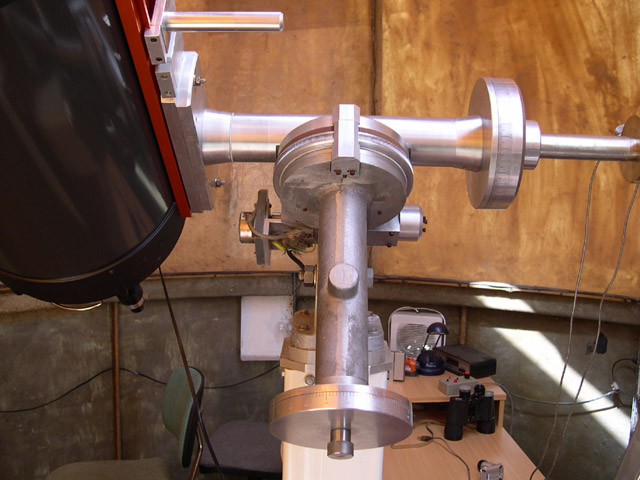|
SETTING CIRCLES and HOW TO USE THEM : Dave Tyler's Method
For me True setting circles must enable you to find planets in daylight by:
Right Ascension can be thought of as the Longitude of the Heavens, measured in hours. Declination an elevation angle related to the north celestial pole I could never understand how to use setting circles from books , so I invented my own method. The breakthrough came as it dawned on me that the listed RA of an object is the same as LOCAL SIDEREAL TIME as that object crosses the southern meridian. Get your head round that and you will be well away. The southern meridian can be thought of as this ; Stand facing south reach backwards over your head and draw a line in the sky from the pole star to the horizon . As stars pass this " line", the local sidereal time is the same as the RA of the star or planet "transiting this meridian". For example, an object with an RA of 15 hrs will cross the meridian one hour later than one with an RA of 14 hours. An object with an RA of 14 hours will be one hour west of the south meridian, if your sidereal clock is reading 15 hours. OK ? if not please read it again and again until the penny drops. When it does you really will have cracked it. Download this free onscreen sidereal clock to your desktop here Right click the clock. Set the colour text to white, anything other than the default black, or you wont see it. Put in your longitude , which is available from MULTIMAP from your post code, its not really a total decimal entry, put in degrees mins and secs. Now click update, and you have your local sidereal time Download free Jupos software here This is a great piece of software for finding the RA and DEC of the moon and planets. Click the planet you want / tools / ephemirides / ephemirides or graphics / real time. You will now see a host of useful information apart from the RA and DEC. This includes altitude and elevation, sunrise and sunset,(put in your latitude and longitude for this information to be accurate), the current apparent angular diameter of the planet ,and much more. Choosing graphics will show you where Jupiters moons are. STARTING WITH A REASONABLY ACCURATELY SET UP EQUATORIAL MOUNT.
1. POINT THE TELESCOPE SOUTH . ( at the southern meridian)
2. PUT TWO MARKS ON YOUR MOUNT. You are now ready to locate a planet like Mars Jupiter or Venus , in daylight , if its bright enough, or any object at night, that can be seen by your finder and is available to you at this time of the year at your latitude. a. Let's say Jupiter in twilight a half hour before sunset. Look up its RA and DEC , jot it down.b. Move the scope in elevation to set the declination circle to read the required declination. c. Leave the dec as set and move the scope in RA only to point south, the dec axis is now horizontal, well it should be!
Now You now need to move the scope in RA, by the amount that is the difference between your local sidereal time reading, and the known RA of the planet. You will need to move west if the planet RA is less than your Local Sidereal Time, or east if it is greater than your LST. Once I am pointing south, my RA circle can be unlocked from the polar axis and spun round and locked, to read the same as my sidereal clock , I then simply move the scope so that the circle now reads the same as the planet's RA. If you cannot do that, just move the scope off south to the west by the ammount that the object has gone past the meridian i.e. subtract RA from LST. OR off south to the east by the amount of time found by taking LST from the object's RA figure.
Snags: |
| Click on any image below to see the full-sized view |
 |
 |
| RA circle with vernier scale to read to one minute | Note DEC axis is horizontal when scope is pointing to the southern meridian |
 |
|
| South pointer with an indicator both sides of DEC housing |